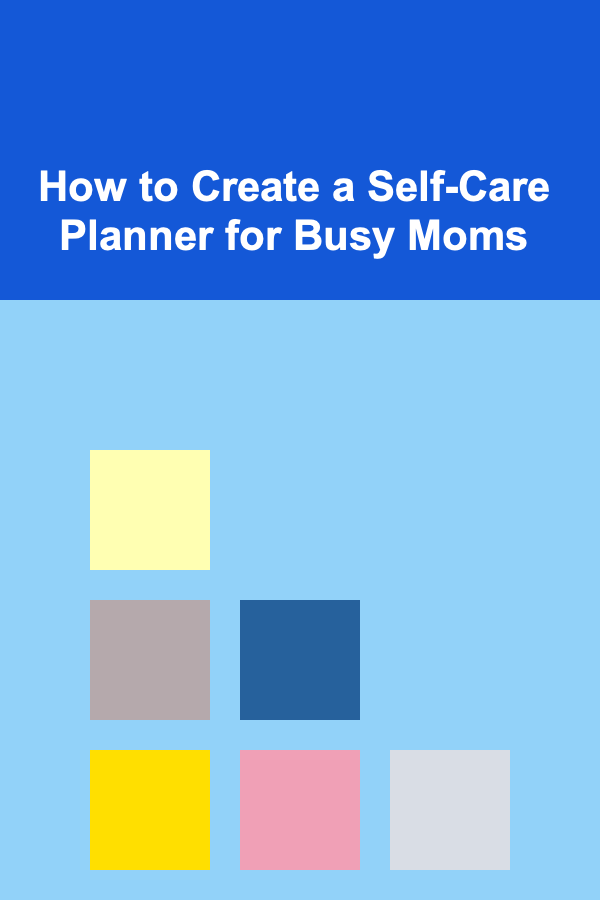
How to Create a Self-Care Planner for Busy Moms
ebook include PDF & Audio bundle (Micro Guide)
$12.99$5.99
Limited Time Offer! Order within the next:

Being a mother is one of the most rewarding, yet demanding roles a person can have. Between caring for children, managing household duties, and potentially juggling a career, many moms find it difficult to carve out time for themselves. As a result, self-care often takes a backseat. However, self-care is essential, not only for maintaining physical health but also for emotional well-being, reducing stress, and preventing burnout. One effective way to ensure that self-care remains a priority is by creating a self-care planner.
A self-care planner is a tool that helps busy moms incorporate self-care practices into their daily, weekly, and monthly routines. It serves as a roadmap, reminding them to take small steps toward maintaining their mental, emotional, and physical health. This guide will provide a step-by-step approach on how to create a self-care planner that is personalized, practical, and achievable.
Understanding the Importance of Self-Care for Moms
Before diving into the process of creating a planner, it's essential to understand why self-care is so important, especially for mothers.
- Physical Health: Moms are often on their feet all day, running after children, preparing meals, and managing household chores. Over time, neglecting physical health can lead to exhaustion, weakened immune systems, and long-term health issues.
- Mental Health: The mental load of motherhood is significant. From managing schedules to addressing children's emotional needs, moms can easily become overwhelmed. Taking time for self-care helps reduce stress, anxiety, and mental fatigue.
- Emotional Well-Being: Moms give so much of themselves to others, but they also need to replenish their emotional reserves. Self-care practices such as journaling, meditating, or engaging in creative hobbies can help restore balance.
- Avoiding Burnout: Without self-care, burnout becomes inevitable. Moms who fail to take time for themselves may experience feelings of frustration, resentment, and emotional exhaustion. Regular self-care prevents these negative emotions from taking over.
What to Include in a Self-Care Planner
Creating a self-care planner is about designing a tool that fits seamlessly into a busy mom's life. The planner should be practical, flexible, and easy to use. Here are the essential components to include:
2.1 Daily Self-Care Tasks
The daily section of your planner is where you will outline quick, simple self-care activities that can easily fit into your day. These activities should be things that nourish your mind, body, and soul but don't require too much time.
Examples of Daily Self-Care Tasks:
- Morning Meditation (5-10 minutes): Start your day with mindfulness. This could be as simple as taking a few deep breaths or practicing gratitude.
- Hydration: Keep track of your water intake. A hydrated body is a healthy body.
- Stretching or Light Exercise: Incorporating a few minutes of stretching, yoga, or a short walk helps release tension.
- Reading: Spend 10-15 minutes reading something inspirational, educational, or for pure enjoyment.
- Journaling: Write down your thoughts, affirmations, or reflections.
These daily activities will encourage consistency in your self-care routine, ensuring that you take small steps toward prioritizing your well-being every day.
2.2 Weekly Self-Care Goals
A weekly section allows for more intentional, larger acts of self-care that may require a little more time. This is where you can plan for more significant activities that contribute to your well-being but don't necessarily need to be done every day.
Examples of Weekly Self-Care Goals:
- Date Night (with or without a partner): Setting aside time to connect with your partner, even if it's at home after the kids are asleep, can do wonders for your emotional health.
- Pampering Session: Treat yourself to a bath, face mask, or skincare routine.
- Physical Activity: Try a new workout class, take a long walk, or practice a sport you enjoy.
- Social Time: Meet up with friends, schedule a phone call with a loved one, or attend a social event.
- Decluttering or Organizing: Set aside time to organize a small area of your home. A clean space can lead to a clear mind.
The weekly section is for activities that require more effort or planning but are still achievable and provide substantial benefits.
2.3 Monthly Self-Care Reflections
The monthly section of your planner is an opportunity for you to look back and reflect on how you've been taking care of yourself. It's also a time to assess what has worked, what hasn't, and set new self-care goals for the coming month.
Examples of Monthly Self-Care Reflections:
- Reflection on Mental Health: Take a moment to check in with yourself. How have you been feeling emotionally? Have you noticed any signs of stress, burnout, or anxiety? What can you do to address these feelings?
- Physical Health Check: How have you been feeling physically? Are there any physical issues or discomforts you need to address? Have you been keeping up with exercise or rest?
- Self-Care Wins: Celebrate your self-care achievements, no matter how small. Did you find time for meditation? Did you go for a walk every day? Did you have a long-overdue conversation with a friend?
- Goal Setting for the Next Month: Reflect on the upcoming month. What new goals can you set for your physical, emotional, or mental health? Is there something new you want to try?
This section helps you stay accountable, track your progress, and make adjustments to ensure you're continuing to prioritize your well-being.
Personalizing the Planner to Fit Your Life
Not every mom's schedule is the same, so your planner should be flexible and adaptable to your individual needs. Here's how you can personalize the planner:
3.1 Time Blocking
Time blocking is a technique where you allocate specific time slots in your day for different activities. This is especially helpful for busy moms who may find it difficult to find time for self-care. By setting aside designated time for self-care activities, you make them a priority.
For instance, you could block off 10 minutes each morning for meditation or 30 minutes every Sunday afternoon for a self-care bath. Time blocking helps eliminate the excuse of "not having time."
3.2 Use Visuals
For visual learners, adding visuals to your planner can be motivating. You can incorporate stickers, color coding, or even inspiring quotes that resonate with you. A well-designed planner that feels good to look at can make the process more enjoyable.
3.3 Flexible Routines
Life is unpredictable, especially with kids. There will be days when you can't follow your planner to the letter, and that's okay. It's important to have a flexible routine, where you can adapt your self-care goals depending on how much time and energy you have.
You might need to swap activities or cut them short on busier days, but that's better than skipping them altogether. Allow your planner to be a guide, not a rigid set of rules.
3.4 Accountability
Having an accountability partner can keep you motivated. Share your self-care planner with a friend or family member, or create a small group of mom friends who can check in on each other's progress. Encouraging each other to prioritize self-care helps to stay on track.
Technology and Tools to Enhance Your Planner
While a physical self-care planner is great, technology can offer some useful tools and reminders that will help you stick to your routine. Here are a few options:
4.1 Self-Care Apps
There are many apps designed to track and encourage self-care practices. These apps can send reminders, offer mindfulness exercises, and even track your water intake or steps. Some popular self-care apps include:
- Headspace: Guided meditation and mindfulness.
- MyFitnessPal: For tracking nutrition and exercise.
- Calm: Offers sleep stories, breathing exercises, and relaxation techniques.
4.2 Digital Calendars
If you prefer a digital format, Google Calendar or other digital calendars can be helpful for scheduling time blocks for self-care. You can set recurring events for daily, weekly, and monthly tasks.
4.3 Online Communities
Joining online communities or groups focused on self-care for moms can provide motivation, inspiration, and support. These groups can be on social media, forums, or in the form of email newsletters or blogs.
Overcoming Obstacles to Self-Care
It's common for busy moms to feel guilty about taking time for themselves. They may feel as though they should always be focusing on their children or household duties. Overcoming these feelings requires a mindset shift.
- Self-Care is Not Selfish: It's essential to realize that by taking care of yourself, you are better able to take care of your family. You can't pour from an empty cup.
- Start Small: Begin with just a few minutes a day. Small actions add up over time.
- Let Go of Perfection: Don't stress about doing everything perfectly. The goal is progress, not perfection.
Conclusion
Creating a self-care planner is an empowering step for busy moms to take control of their well-being. It allows you to intentionally carve out time for yourself amidst the chaos of daily life. By incorporating small but impactful self-care activities into your routine, you can experience better physical health, improved mental clarity, and a greater sense of emotional fulfillment. The key to success is consistency, flexibility, and making self-care a priority in your life. Remember, you are worthy of care and attention, and by taking care of yourself, you will be better equipped to take care of others.
Reading More From Our Other Websites
- [Toy Making Tip 101] Simple DIY Toys: Easy Projects for First-Time Creators
- [Whitewater Rafting Tip 101] Family-Friendly Rafting: Adventures for All Ages and Skill Levels
- [Organization Tip 101] Why You Need a System for Managing Household Bills
- [Organization Tip 101] How to Maximize the Effectiveness of Window Insulation Film
- [Home Maintenance 101] How to Prevent and Treat Stains on Your Carpet and Rugs
- [Personal Care Tips 101] How to Choose Aftershave for a Refreshing Start to Your Day
- [Needle Felting Tip 101] Mastering Texture: How to Achieve Realistic Fur Effects with Needle-Felted Wool
- [Home Lighting 101] How to Incorporate Mid-Century Modern Lighting into Your Home
- [Organization Tip 101] How to Organize Maintenance Requests Efficiently
- [Personal Care Tips 101] How to Choose Between Acetone and Non-Acetone Nail Polish Remover

How to Organize Your Home to Maximize Floor Space
Read More
How to Use Mason Jars for Craft Supply Storage
Read More
How to Harvest Biomass Energy at Home
Read More
How To Use Your Blog or Website for Job Search: A Comprehensive Guide
Read More
How to Organize and Maintain Executive Files and Records
Read More
10 Tips for Mastering Commercial Pilot Radio Communication
Read MoreOther Products

How to Organize Your Home to Maximize Floor Space
Read More
How to Use Mason Jars for Craft Supply Storage
Read More
How to Harvest Biomass Energy at Home
Read More
How To Use Your Blog or Website for Job Search: A Comprehensive Guide
Read More
How to Organize and Maintain Executive Files and Records
Read More